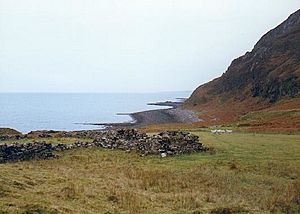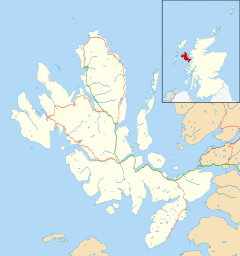Boreraig facts for kids
Quick facts for kids Boreraig
|
|
|---|---|
 A ruined croft at Boreraig |
|
| OS grid reference | NG6116 |
| Council area | |
| Lieutenancy area | |
| Country | Scotland |
| Sovereign state | United Kingdom |
| Post town | ISLE OF SKYE |
| Police | Northern |
| Fire | Highlands and Islands |
| Ambulance | Scottish |
| EU Parliament | Scotland |
| UK Parliament |
|
| Scottish Parliament | |
Boreraig (which is Boraraig in Scottish Gaelic) is a village that is now empty. It is located in Strath Swordale on the north shore of Loch Eishort, on the Isle of Skye in Scotland.
Contents
History of Boreraig
Life in Early Boreraig
Boreraig was once a busy village, set in a green and sunny valley. It was a traditional baile, which means a settlement, before the system of crofting became common. Crofting is a special way of farming small pieces of land in Scotland.
In 1853, the people of Boreraig were forced to leave their homes. This was part of a sad time in Scottish history called the Highland Clearances. During this time, many landlords, like Lord MacDonald, wanted to use the land for sheep farming instead of for people.
Many families, mostly farmers called crofters, had to move away. Records from 1851 show that about 120 people lived in Boreraig. They lived in 22 households. Most people worked as crofters, farm workers, or farm servants. There were also weavers, a fisherman, and a house carpenter.
Old records from 1823 show that the 22 households shared ten areas of land. Each area was about 6 acres (2.4 hectares). Many of the people in Boreraig were related to each other. Many families had the last name MacInnes.
Moving Away from Boreraig
The forced move from Boreraig happened when the Highland and Island Emigration Society was very active. This group helped about 5,000 people from the Scottish Highlands and Islands move to Australia. By 1853, the Society had agreed to help almost half of Boreraig's families (eight out of 22 households) move to Australia.
In 1852, some families from Boreraig sailed on ships called the Araminta, the Allison, and the Ontario. Later that year, five more families from Boreraig planned to move with the Society. They were supposed to sail on a ship called HMS Hercules. However, some people on board became very ill, and the ship had to stop in Ireland.
Other Boreraig families decided not to use the Society's help. Records show that about seven of the families who lived in Boreraig in 1852 later found new homes in other villages.
Boreraig Today
Today, Boreraig is empty of people. All that remains are the ruins of the old houses. Many of the walls still stand tall. You can also see the old stone walls that divided the fields. The biggest ruins are from the house and farm buildings of the tenant-farmer. The last people left the village in 1877. The people who lived there spoke Scottish Gaelic.
The sheep farmhouse was left empty in 1910. However, the land is still used for grazing sheep. About 300 North Country Cheviot sheep live there. These sheep are "hefted," meaning they naturally stay in this area. They are looked after from a nearby place called Kilbride. It is impossible to reach Boreraig by car. This means it's hard to bring food for the sheep in winter. But the land in Boreraig is very fertile, so the sheep usually stay healthy.
You can find a standing stone in Boreraig. There is also a special footbridge over a stream. It is made from a single large stone slab. People say one strong man, known as "Glagan-glùine" or "Knock-knees," lifted it into place in the early 1700s. You can also see the remains of an old fort (called a dun) and a place where boats could anchor.
Many people enjoy a circular walk of about 8 to 9 miles (13 to 14.5 km) that includes Boreraig. The walk starts and ends at Kilchrist (Cill Chrìosda). It also goes through the nearby villages of Suisnish (Suidhisnis) and Kilbride (Cille Bhrìghde).
Today, the land in Boreraig, like much of Strath Swordale, is owned by the Scottish Government.
Images for kids





